Mother's day is a much bigger deal than Father's day. Why? Well, there's just something extra special about mom (sorry Dad!). So, today's post is about an under-appreciated group of moms (you guessed it), Arizona black rattlesnakes!
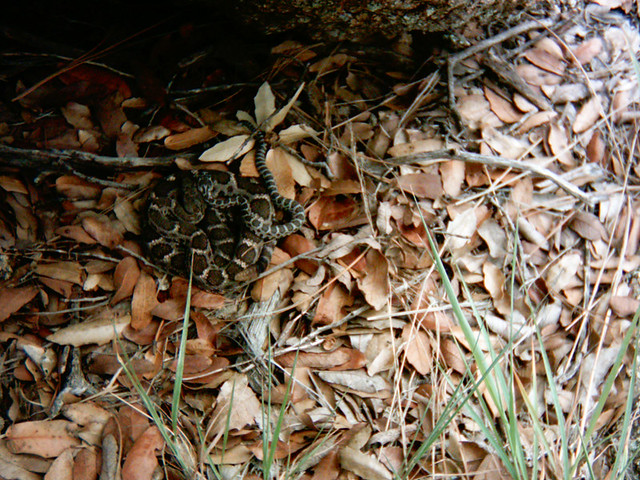
Human moms - you think you have it tough? Rattlesnake maternal duties may only last a couple weeks, but during that time they may have to protect their kids from extreme temperatures, a suite of predators, annoying (and deadly?) squirrels, and clumsy humans with cameras... By the time they give birth, mother rattlesnakes likely haven't eaten in weeks or even months, but they wait another couple weeks to give full attention to their newborns. So here's to you rattlesnake mommies!
We'll start with the most famous of all, Cap Mama, who showed us what a typical day is like for a new rattlesnake family:
For an explanation of the behaviors seen in that video, check out this post.

What a beautiful family she has!
Sigma may have been one of our smaller mothers, but what she lacked in size she made up for in bravery:
Check out the full story of Sigma's squirrel battles here.
We've been lucky enough to see Woody and Alice with two different litters.

Alice's family, 2010

Alice's family, 2012
Woody's family, 2012. You can watch more timelapse videos of Woody's family here and here.
Every mom needs a day off. So the lucky (or smart?) rattlesnakes that nest in groups help each other out with maternal duties. If one is still pregnant, and thus needs to be on the surface basking, she attend to the newborns while the new mother stays in cover for a well-deserved rest. Priscilla was the first rattlesnake we observed exhibiting this baby-sitting behavior.
 You can read more about Priscilla and House here.
You can read more about Priscilla and House here.
Male rattlesnakes occasionally help out in this way too. Although we've never observed any active care or protective behavior from males, just the presence of a large rattlesnake may be enough to deter some predators.
Still image of the group:
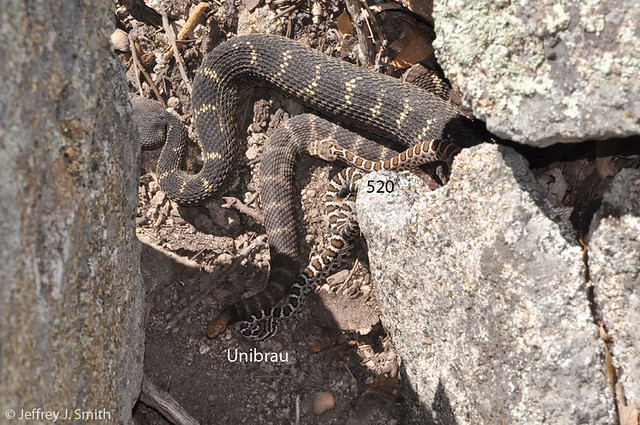
Green Male (adult male) is the large black rattlesnake at the top of the image and the mother (Devil Tail) is the smaller, brown adult (mostly her tail and rattle are visible).
A handful of newborns follow Roger (adult male) out of the nest entrance to a preferred basking spot.
Sometimes the youngest (smallest) mom gets stuck with the surface duties of caring for the newborns. Eve was the smallest of the pair of snakes that nested at this site; we saw her often on the surface with way too many babies to have all been her own. The older (larger) female was rarely seen on the surface with the newborns.

This is the first Mother's day in years that we haven't spent at dens with our rattlesnake mothers-to-be. But, as of last week, two (Persephone and Luna) of our three Muleshoe rattlesnakes are still near their dens. While this is atypical rattlesnake behavior in general, it is characteristic of pregnant Arizona black rattlesnakes. So maybe we'll have a couple more names to add to this list next year!
Sunday, May 12, 2013
Monday, August 20, 2012
Friday evening while tracking Jaydin, we came across an Arizona black rattlesnake (Crotalus cerberus) hunting along an old corral fence.
BeeGee was still there the following morning, so we decided to put a camera on him.
While we have captured interactions between rattlesnake species and with squirrels before, it was pretty exciting to see both in one day!
What was going on between the Arizona black and western diamond-backed rattlesnakes? We don't know and would love to hear your thoughts in the comments below. For more information on squirrel - rattlesnake interactions, check out the work done by Rulon Clark's lab and his student Bree's blog.
In case the interspecies interactions weren't cool enough, BeeGee also demonstrated his species' ability to change color:
Friday, December 16, 2011
Squirrels and rattlesnakes have a complicated relationship. Some squirrels have developed resistance to rattlesnake venom so that an adult squirrel can survive a rattlesnake bite. Juvenile squirrels cannot, so they are often still prey to rattlesnakes. Because of their resistance, adult squirrels will confront rattlesnakes that wander near their colonies and sometimes even kill them!
For more information on rattlesnake-squirrel interactions, check out research from Rulon Clark’s lab and his student Bree Putman’s blog. Now on to Sigma’s story…
We first met Sigma on 23 April 2011 when she was basking near her den. She was named for one of her many weird blotches that is shaped like the Greek letter.
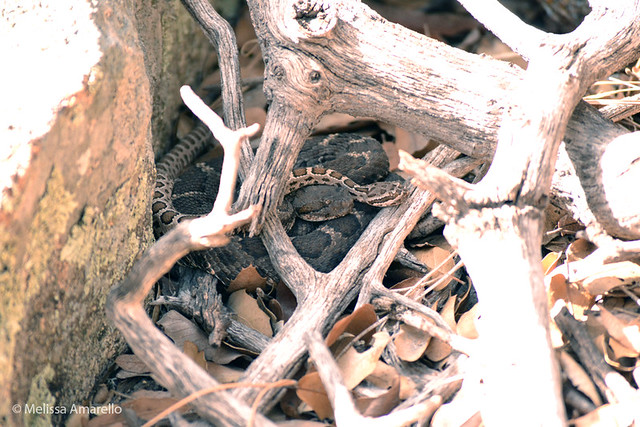 Sigma and Barb, 24 April 2011. Barb was born here, to another female (Devil Tail), the previous September (2010).
Sigma and Barb, 24 April 2011. Barb was born here, to another female (Devil Tail), the previous September (2010).
6 August: We return to the dens and find Sigma at large rock near her den that will be her nest site. Toward the end of her pregnancy, she settles on the west side of the rock as her main basking area, so we set up a timelapse camera there.
Between 3 and 4 September, the squirrel appears to be investigating the nest rock, but never when Sigma is on the surface.
On 5 September, Sigma and the squirrel meet:
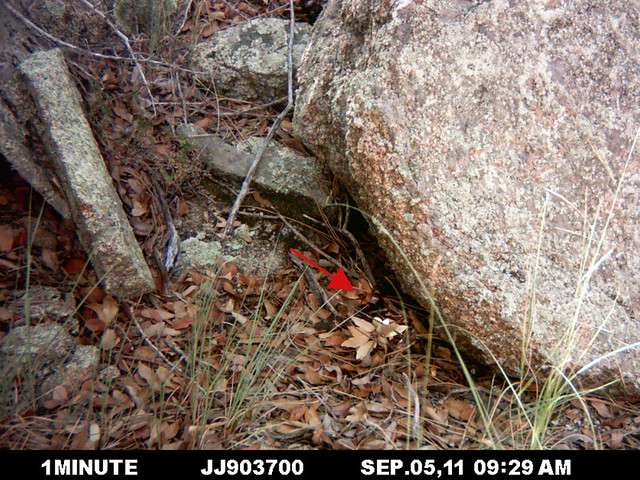 Sigma (at end of arrow) emerging for the first time that day
Sigma (at end of arrow) emerging for the first time that day
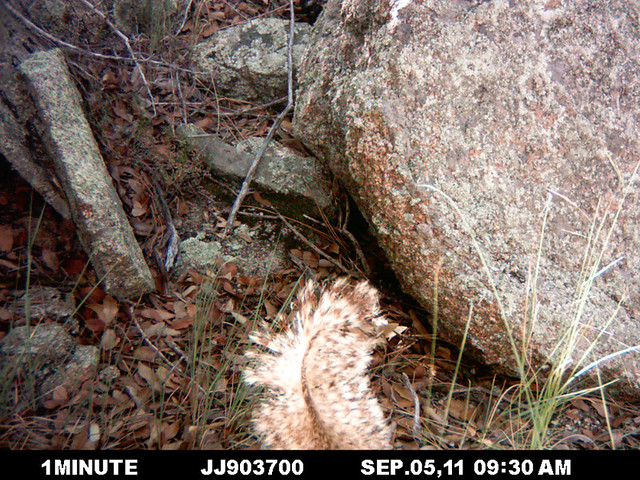 The squirrel confronts Sigma
The squirrel confronts Sigma
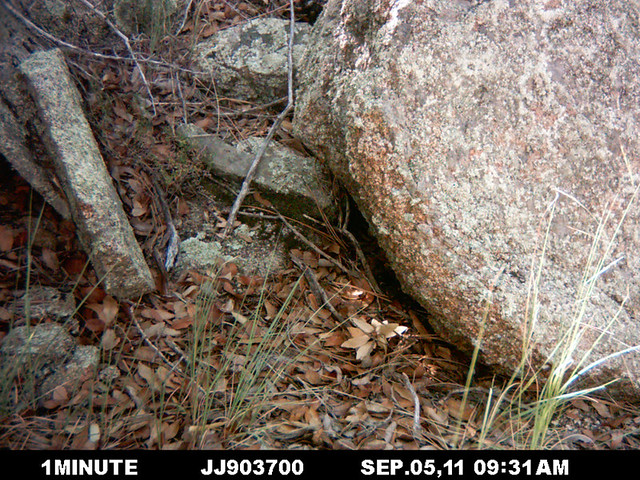 Sigma immediately retreats beneath her nest rock
Sigma immediately retreats beneath her nest rock
6 September: Sigma sticks her head out and looks around before emerging (like Cap Mama ). About an hour later, the first of her four neonates emerge from beneath the rock:
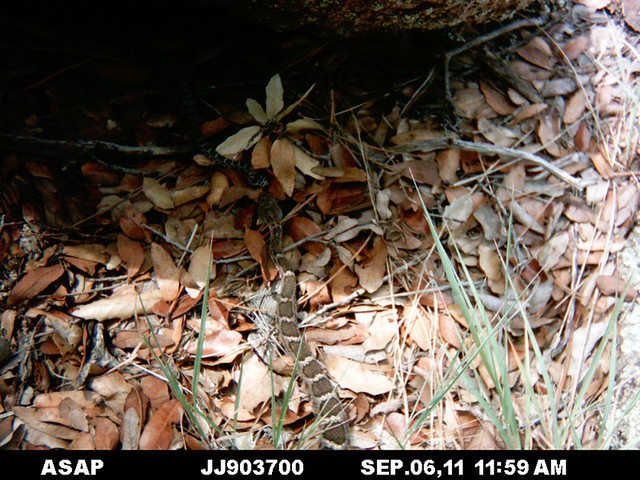
The following video captures Sigma’s family’s first day together (warning: its kinda long, 4 minutes). Watch for the squirrel’s appearance at 12:14PM.
The squirrel does not return (that we can see) the following day and the family spends most of it on the surface:

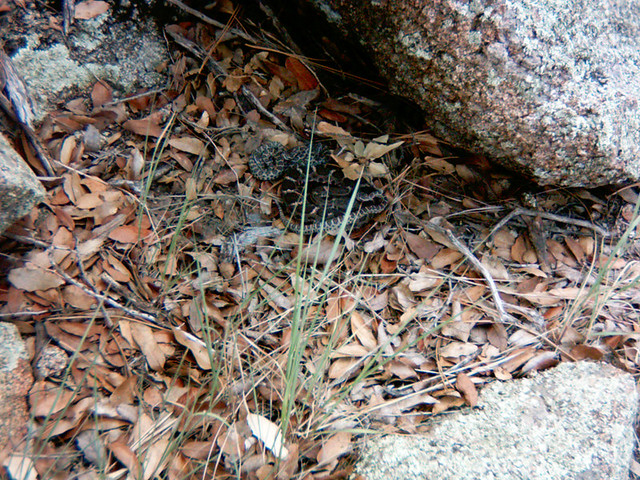
Timelapse video of 8 September:
What starts as a peaceful day for the family was rudely interrupted by the squirrel at 11:27AM. Just before the squirrel appears in the video, Sigma turns and assumes an S-coil defensive posture typical of rattlesnakes:
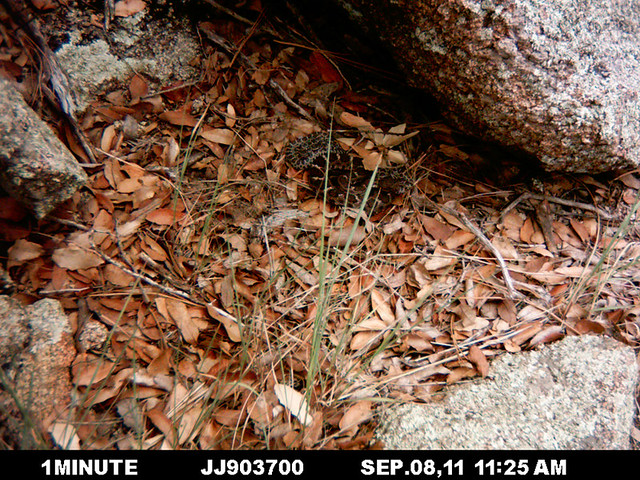 Sigma at rest with her family
Sigma at rest with her family
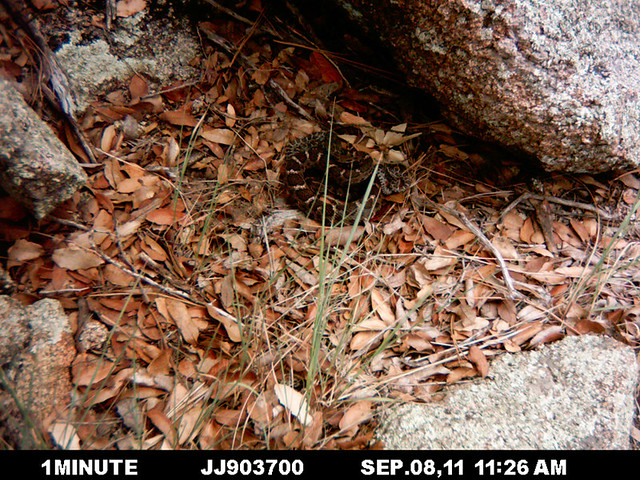 Sigma turns, expands her body to look as large as possible, and assumes a ready-to-strike (S-coil) defensive posture.
Sigma turns, expands her body to look as large as possible, and assumes a ready-to-strike (S-coil) defensive posture.
What you can’t see in the video was captured by our overhead camera; Sigma is posturing to the squirrel just off screen:
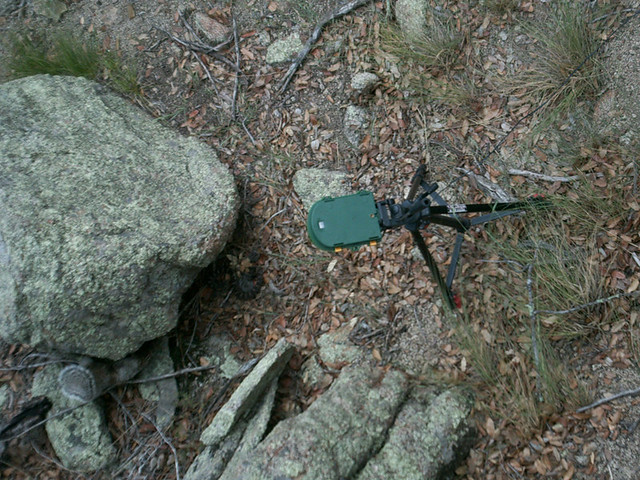
The family immediately disappears; Sigma reemerges only after the squirrel is gone. The first neonate to emerge is quickly chased back under the nest rock by the squirrel (~11:54AM–12:01PM in the video).
9 September: After the squirrel interactions, the family seems to spend much less time on the surface (at least where the cameras can see). We recorded only one additional, indirect, interaction between Sigma and the squirrel:
As it often did when there weren’t snakes visible, the squirrel appears to be looking underneath the nest rock. Sigma returns, takes on the familiar defensive posture and appears to be rattling – although it’s difficult to be certain because the timelapse photos were taken at one-minute intervals.
Our camera continued to record at this location until 18 September and the squirrel returned about every other day, usually looking underneath the nest rock. Sigma and her four neonates were never seen together again, but we cannot say if they changed their behavior or if one or more neonates were injured or killed. One limitation of remote photography is that our knowledge is limited to what happened in view of the camera. However, it is unlikely that any of these squirrel-rattlesnake interactions would have occurred if a human observer was present. We never saw anything like this when we monitored rattlesnake families in person – have you?











